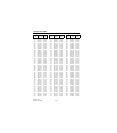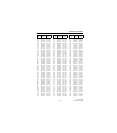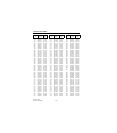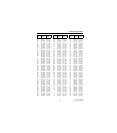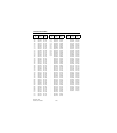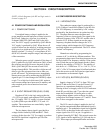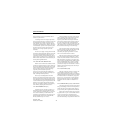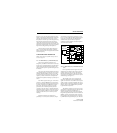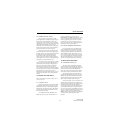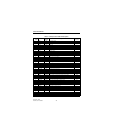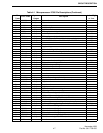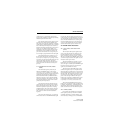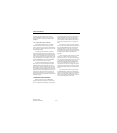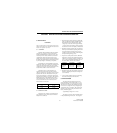
CIRCUIT DESCRIPTION
4-4
November 1999
Part No. 001-7780-500
input signal to these transistors is high for narrow
band channels. Therefore, with narrow band chan-
nels, D14/D16 are forward biased and D13/D15
reverse biased and vice versa for wideband channels.
The450kHzsignalfromthesefiltersisthenfed
backintoIC3onpin5andappliedtoalimiter-
amplifier stage. From the limiter the signal is fed to
the quadrature detector. An external phase-shift
network connected to pins 10 and 11 shifts the phase
of one of the detector inputs by 90° at 450 kHz (the
other inputs are unshifted in phase). This network
consists of C17 and ceramic discriminator X1. The
detector is adjusted for wide and narrow band chan-
nels by Q3, R8, and C16. The detected audio signal is
then amplified and fed out of IC3 on pin 9.
4.3.3 SQUELCH CIRCUIT (IC4A/B, IC5A)
The audio output signal on pin 9 of IC3 contains
audio and also high-frequency noise. This signal is fed
to the receive audio and data processing circuits on the
logic board (Section 4.6.1) and also to the squelch
circuit. The amount of noise in this signal tends to be
inversely proportional to signal strength (the higher
the noise level, the lower the signal strength and vice
versa). Therefore, it can be used for squelch control.
A bandpass filter that passes only noise frequen-
cies occurring above the audio band is formed by an
op amp in IC3 and external components. The input to
this filter is pin 8 and frequency determining compo-
nents (R17-R19, C20, C21) are connected to pin 7.
Other components on the input such as Q4 provide
frequency and wide/narrow band compensation, and
thermistors R14/R26 provide temperature compensa-
tion. The input audio/noise level is adjusted by R13.
The detected noise output on pin 13 of IC3 is applied
to pin 32 of the microprocessor in the logic unit.
4.4 TRANSMITTER DESCRIPTION
NOTE: A block diagram of the RF and logic units is
located on page 8-3.
4.4.1 AMPLIFIER (Q9), DRIVER (Q8)
In the transmit mode, the VCO output signal is
the transmit frequency. It is switched to the transmitter
by the switching circuit consisting of D7 and other
components (see Section 4.2.2) and applied to ampli-
fier Q9. Power to this stage and also Q8 is the 7.5-volt
battery supply switched by Q16 and Q17. This switch
is controlled by the switched T5V supply. Therefore,
when the transmit mode is selected, the TX5V supply
goes high which causes the output of Q17 to go low
and turn switch Q16 on.
The output signal from Q9 is fed to driver Q8
which provides additional amplification. Impedance
matching with IC1 is provided by L15, C62, and a
resistive pad consisting of R41-R43. Power amplifier
module IC1 provides up to 3 watts of RF power at the
antenna jack. It contains three internal amplifier
stages, each of which has a separate supply voltage
(VCC1-VCC3). The supply voltage to the first stage
(VCC1) is from the power control circuit, and the
supply voltage to the last two stages (VCC2/VCC3) is
the unswitched battery supply.
4.4.2 ANTENNA SWITCH AND LOW-PASS
FILTER
The antenna is switched between the receiver and
transmitter by an antenna switch consisting of D11,
D1-D3, and several other components. In the transmit
mode, the TMUT input on pin 2 of Q7 is high. The
T5V supply on pin 4 then appears on pin 3 and current
flows through R20, L14, D11, D3, and L1/D1 and
L2/D2. Since D11 and D3 are forward biased, the
transmit signal has a low impedance path to the
antenna.
L14/C31, L1/C2/D1, and L2/D2/C17 each form
discrete quarter-wave line that is AC grounded at one
end. When one end of a quarter-wave line is AC
grounded, the other end presents a high impedance to
the quarter-wave frequency. Therefore, L14/C31
isolate the 5-volt battery supply from transmitter RF,
and the other two circuits isolate the receiver. In the
receive mode, D11 and D1-D3 are no longer forward
biased. Therefore, the receive signal has a high-
impedance path into the transmitter and a low-imped-
ance path into the receiver. From the antenna switch
the transmit signal is fed to low-pass filter FI7. This
filter attenuates harmonic frequencies occurring above
the transmit band.



